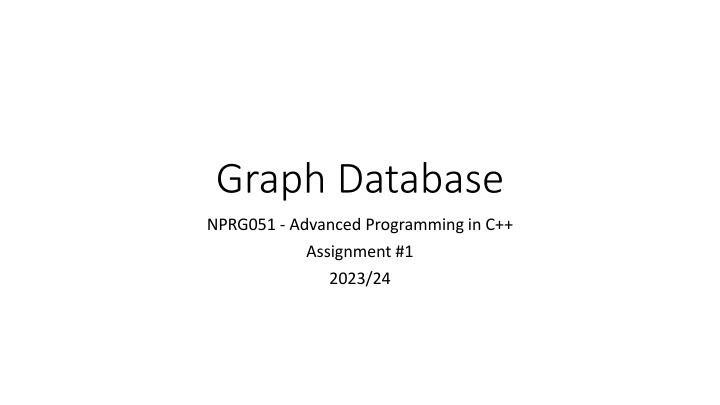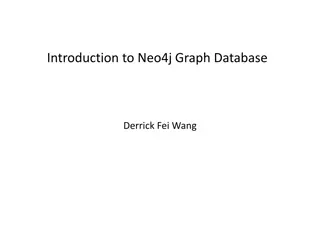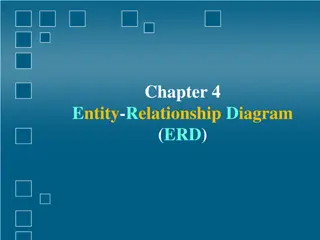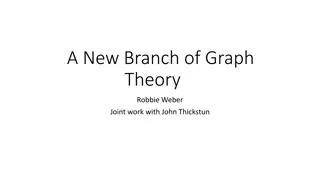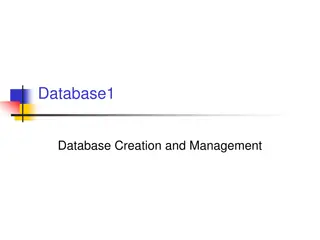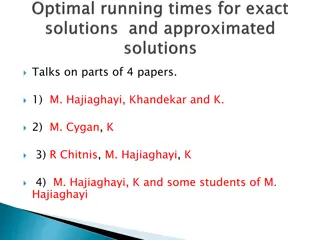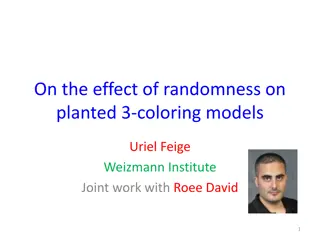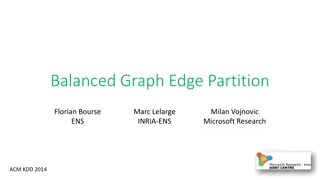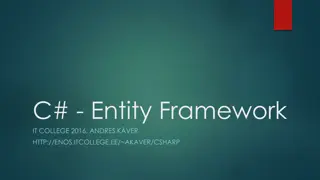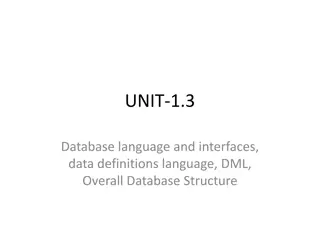Graph Database and Algorithmic Manipulation
This content showcases a comprehensive overview of graph databases, advanced programming in C++, and graph manipulation requirements. It covers topics such as directed graphs, storage methodologies like row and columnar storage, API graph schema structures, data structures, and more. From the basics to advanced topics, it provides insights into graph theory and practical implementations, offering a valuable resource for students and professionals in the field.
Download Presentation

Please find below an Image/Link to download the presentation.
The content on the website is provided AS IS for your information and personal use only. It may not be sold, licensed, or shared on other websites without obtaining consent from the author.If you encounter any issues during the download, it is possible that the publisher has removed the file from their server.
You are allowed to download the files provided on this website for personal or commercial use, subject to the condition that they are used lawfully. All files are the property of their respective owners.
The content on the website is provided AS IS for your information and personal use only. It may not be sold, licensed, or shared on other websites without obtaining consent from the author.
E N D
Presentation Transcript
Graph Database NPRG051 - Advanced Programming in C++ Assignment #1 2023/24
Directed Graph v1 v4 v1 v3 v2 https://en.wikipedia.org/wiki/Graph_(discrete_mathematics)
Requirements Graph manipulation Start with empty graph Add a vertex/edge Vertex/edge removal not supported Graph traversal Pass through all vertexes/edges Pass through all outgoing edges for each vertex User-defined types as vertex/edge identifiers User-defined lists of vertex/edge attributes Stored column-wise
Row storage std::vector<int [3]> struct point_3d { int x; int y; int z; }; std::vector<point_3d> points; {1, 2, 3} {4, 5, 6} {7, 8, 9} {10, 11, 12} {13, 14, 15} Memory 1 2 3 4 5 6 7 8 9 10 11 12 13 14 15
Columnar storage std::vectors xs[3] xs ys zs struct points_3d { std::vector<int> xs; std::vector<int> ys; std::vector<int> zs; }; points_3d points; [1, 4, 7, 10, 13] [2, 5, 8, 11, 14] [3, 6, 9, 12, 15] Memory 1 4 7 10 13 2 5 8 11 14 3 6 9 12 15
Columnar storage A struct of arrays vs. An array of structs https://en.wikipedia.org/wiki/AoS_and_SoA Columns optimized for reading of single properties std::vector<bool> is specialized Easier for SIMD instructions
API: graph schema struct graph_schema { using vertex_user_id_t = // vertex id type using vertex_property_t = // vertex property type using edge_user_id_t = // edge id type using edge_property_t = // edge property type };
API: graph schema example struct graph_schema { using vertex_user_id_t = std::string; using vertex_property_t = std::tuple<int, double> using edge_user_id_t = int; using edge_property_t = std::tuple<std::string>; }; ID = Carlos properties: { 30, 3.14 }; v4 ID = 1 properties: { knows }; ID = Thomas properties: { 20, 0.0 }; v1
API: the class graph_db Header: graph_db.hpp Documented template<class GraphSchema> class graph_db { // types // functions for vertexes // functions for edges };
API: functions for vertexes // Add a new vertex into the DB with default properties vertex_t add_vertex(GraphSchema::vertex_user_id_t &&); // Add a new vertex into the DB with given properties vertex_t add_vertex(GraphSchema::vertex_user_id_t &&, Props &&...); // Return [begin(),end()] iterators to all vertexes in DB std::ranges::subrange<vertex_it_t> get_vertexes();
std::ranges::subrange Contains two iterators of given type Readable using begin(), end() for ( auto && v : graph.get_vertexes() ) {/*...*/} get<0>(), get<1>() auto [b, e] = graph.get_vertexes(); std::for_each(b, e, /*...*/);
API: functions for edges // Add a new edge between 2 vertexes into the DB with default // property values edge_t add_edge(GraphSchema::edge_user_id_t &&, const vertex_t &, const vertex_t &); // Add a new edge between 2 vertexes into the DB with given // property values edge_t add_edge(GraphSchema::edge_user_id_t &&, vertex_t, vertex_t, Props &&...); // Return [begin(),end()] iterators to all edges in DB std::ranges::subrange<edge_it_t> get_edges();
API: types using vertex_t = // The vertex type using edge_t = // The edge type using vertex_it_t = // The vertex iterator type using edge_it_t = // The edge iterator type using neighbor_it_t = // The neighbor iterator type
API: the vertex class // Returns id of the vertex GraphSchema::vertex_user_id_t id(); // Returns all properties of vertex GraphSchema::vertex_property_t get_properties(); // Returns a single property value on I-th place auto get_property<I>(); // Set all values of properties void set_properties(PropsType &&...); // Set a single property value on I-th place void set_property<I>(PropType); // A iterator type that traverses outgoing edges using neighbor_it_t = // Return [begin(),end()] iterators to the neighbors std::ranges::subrange<neighbor_it_t> edges();
API: the edge class // Returns id of the edge GraphSchema::edge_user_id_t id(); // Returns all properties of edge GraphSchema::vertex_property_t get_properties(); // Returns a single property value on I-th place auto get_property<I>(); // Set all values of properties void set_properties(PropsType &&...); // Set a single property value on I-th place void set_property<I>(PropType); // Returns the source vertex graph_db::vertex_t src(); // Returns the destination vertex graph_db::vertex_t dst();
Evaluation Upload graph_db.hpp with the correct API into Recodex You can include also your own files Testing suite is available with the example test If it compiles & runs on your machine, it should compile & run in Recodex too Resulting points based on the manual evaluation 10 points in total Functionality (major) Code culture (minor) Readability, no warnings, no memory-leaks, const-correctness, no necessary copies (rvalues, references, ), ...
Hints Use proxy pattern for vertex/edge classes https://en.wikipedia.org/wiki/Proxy_pattern Output iterators https://en.cppreference.com/w/cpp/named_req/OutputIterator
